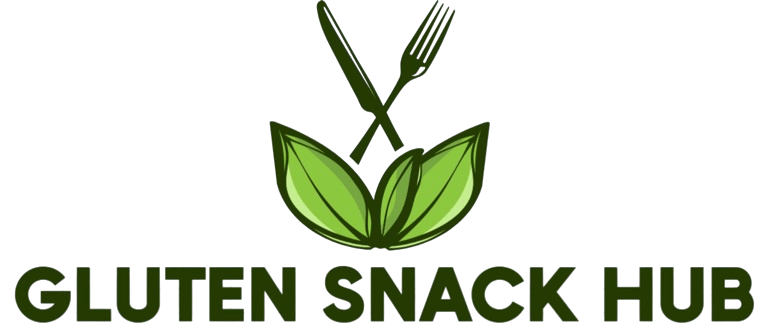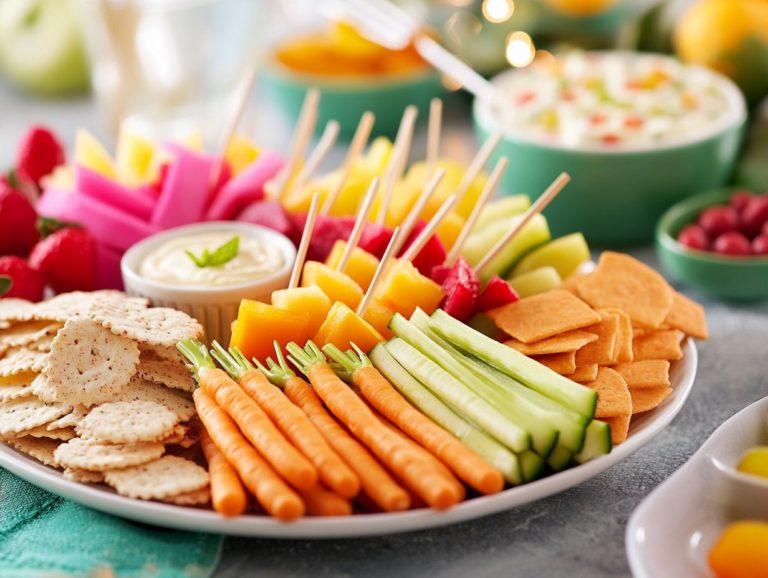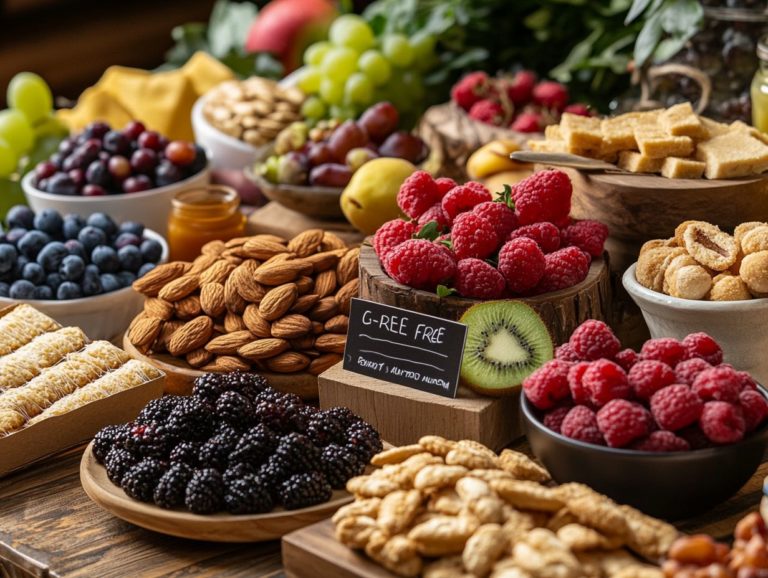Can You Eat Corn on a Gluten-Free Diet?
Navigating a gluten-free diet can present challenges. There are many conflicting messages about what to eat. Understanding the risks of mixing gluten-free and gluten-containing foods is crucial for maintaining a healthy diet.
This guide simplifies the essentials of gluten-free living. It clarifies which foods and grains are safe for you, what to avoid, and whether corn fits into your dietary choices. It also covers corn gluten and the importance of reading labels on processed corn products.
Explore a variety of gluten-free alternatives, including grains, flours, and snacks. This will empower you to make informed decisions on your dietary journey. You will also understand the role of cornmeal, corn flour, and even soy flour in your meals.
Let s explore the exciting world of gluten-free eating together!
Contents
- Key Takeaways:
- What Is a Gluten-Free Diet?
- What Foods Are Allowed on a Gluten-Free Diet?
- What Grains Are Gluten-Free?
- What Other Foods Are Gluten-Free?
- What Foods Should Be Avoided on a Gluten-Free Diet?
- Is Corn Gluten-Free?
- Is Corn Flour Gluten-Free?
- Are Corn Tortillas Gluten-Free?
- What Are Some Gluten-Free Alternatives to Corn and Corn Products?
- Gluten-Free Grains and Flours
- Frequently Asked Questions
Key Takeaways:
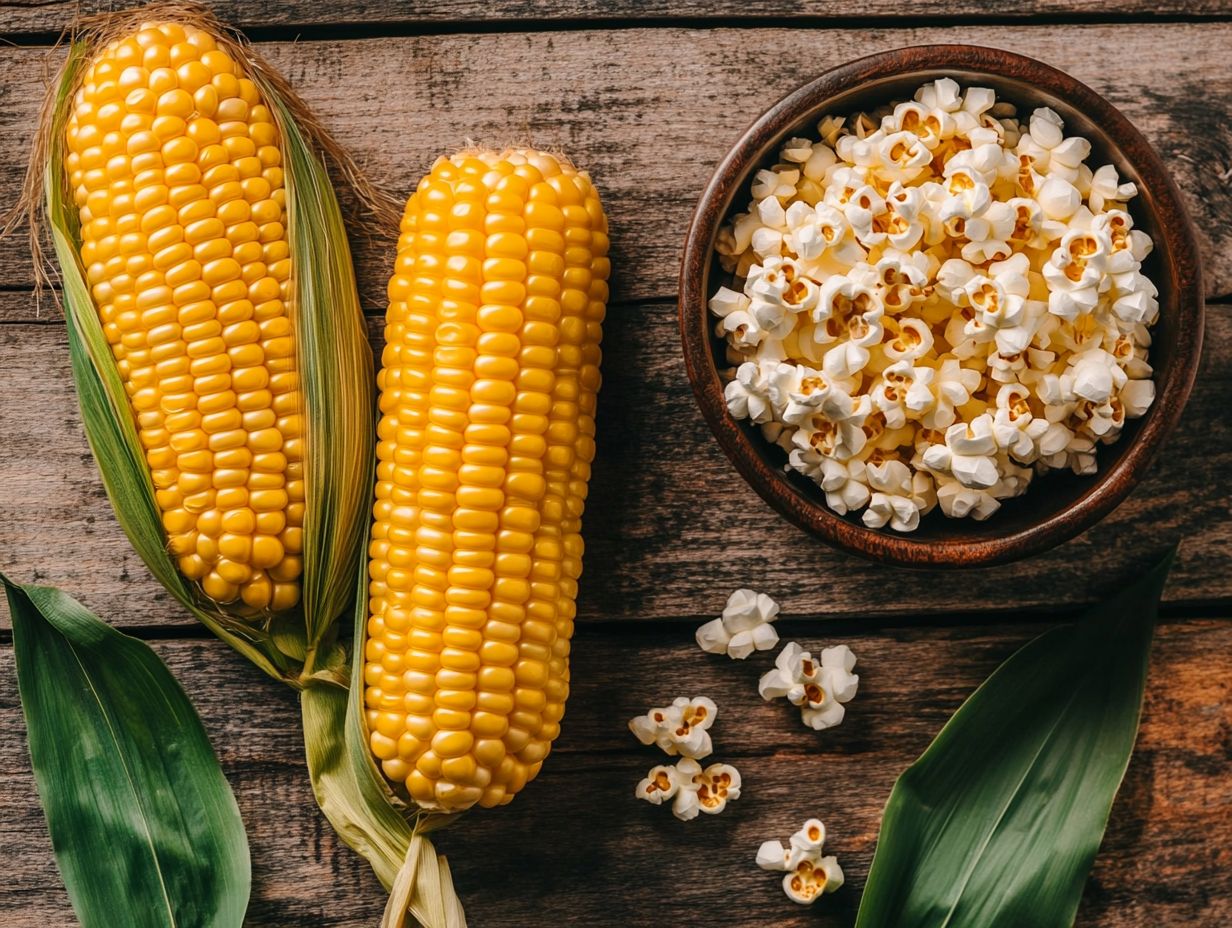
- Corn is naturally gluten-free and can be safely consumed on a gluten-free diet.
- Some corn products may contain gluten, such as corn tortillas made with wheat flour. It’s important to read labels carefully.
- If you’re looking for alternative gluten-free options to corn, consider grains like quinoa and amaranth, and flours like almond or coconut flour. You can also explore gluten-free substitutes such as sorghum and teff.
What Is a Gluten-Free Diet?
A gluten-free diet involves eliminating gluten, a protein present in grains such as wheat, barley, and rye. This protein can provoke negative health reactions in those with conditions like Celiac disease, gluten sensitivity, or gluten allergies.
This dietary choice requires you to be meticulous in selecting food options. Prioritize natural gluten-free products while steering clear of processed foods that might harbor gluten or risk cross-contamination.
It s vital for anyone following this diet to read labels carefully. Seek guidance from medical professionals for health tips and advice, such as those at the Mayo Clinic, as well as reputable resources like the Celiac Disease Foundation and health websites like Verywell Fit.
What Foods Are Allowed on a Gluten-Free Diet?
A gluten-free diet opens the door to a diverse array of foods that are free from gluten. You can enjoy fresh fruits, vegetables, lean meats, fish, poultry, eggs, dairy, and grains like quinoa and amaranth.
You can also indulge in gluten-free corn-based ingredients, such as cornmeal, corn flour, and corn on the cob. These options not only promote a healthy lifestyle but also deliver essential nutrients for those managing gluten sensitivity or Celiac disease.
With the rise of gluten-free brands and commercial products, you ll find plenty of safe gluten-free options that cater to your dietary needs without compromising on taste or nutrition.
Start enjoying delicious gluten-free meals now!
What Grains Are Gluten-Free?
You can confidently explore a range of gluten-free grains that fit perfectly into your gluten-free diet. Quinoa, amaranth, sorghum, and teff are not only packed with essential nutrients but also serve as excellent alternatives to gluten grains like wheat and barley. These gluten-free options provide a delightful variety of ways to use them in cooking, allowing you to enjoy everything from breakfast cereals to baked goods all while savoring a spectrum of flavors and textures without compromising your health.
Incorporating these grains into your everyday meals can enhance both nutritional value and variety. For example, you might use quinoa as a base for vibrant salads or as a hearty side dish. Amaranth can be a wholesome addition to soups, contributing a satisfying texture. Sorghum can be used in cooked dishes, and teff, with its high calcium content, can be part of traditional or vegan recipes.
Sorghum, with its unique nutty flavor, can be popped like popcorn for a nutritious snack or ground into flour for your gluten-free baking adventures. Teff, renowned for its high calcium content, can be prepared as a creamy porridge or used to create traditional injera, a delightful Ethiopian flatbread.
Dive into experimenting with these grains, and discover how they can transform your meals while effortlessly maintaining a gluten-free lifestyle.
What Other Foods Are Gluten-Free?
In addition to gluten-free grains, you ll discover a delightful array of naturally gluten-free foods, including fruits, vegetables, legumes, nuts, seeds, and certain corn products like cooked corn, creamed corn, and popcorn. You can indulge in these without a second thought about gluten. These foods diversify your meals nutritionally and open up a plethora of options for gluten-free snacks and dishes that cater to various tastes and dietary preferences.
As you explore the world of gluten-free options, you ll uncover a treasure trove of culinary delights. Corn products like tortillas made from cornmeal, polenta, and corn flour can serve as versatile bases for everything from wraps to hearty side dishes. These items are rich in nutrients, providing fiber and essential vitamins that contribute to a balanced diet. Adding legumes such as lentils and chickpeas brings in protein and healthy fats, while a vibrant selection of fresh fruits and vegetables offers vital antioxidants.
Together, these gluten-free categories not only support those with dietary restrictions but also encourage flavorful, nourishing meals that everyone can enjoy.
What Foods Should Be Avoided on a Gluten-Free Diet?
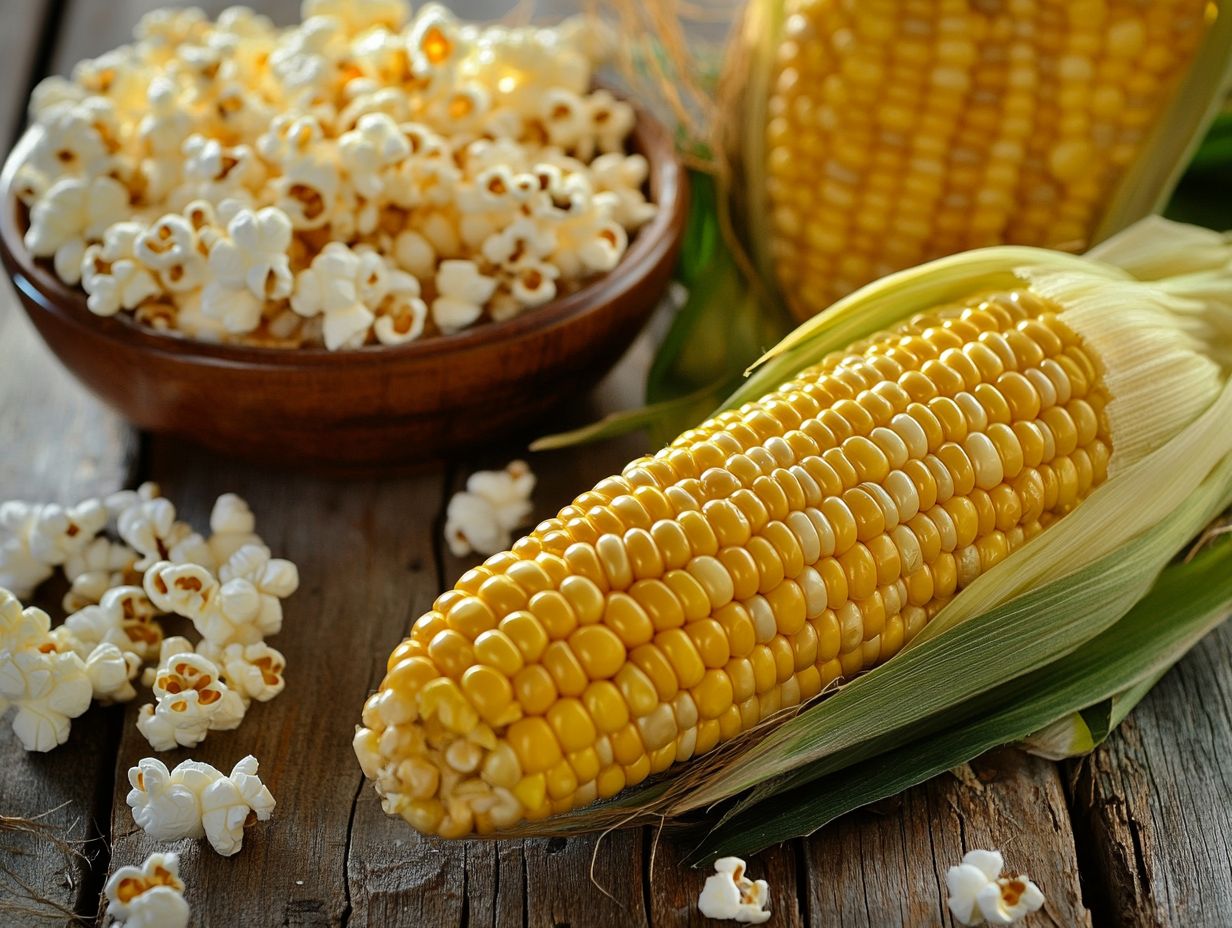
If you’re following a gluten-free diet, it’s essential to steer clear of foods containing gluten, particularly those derived from gluten grains like wheat, barley, and rye.
You should also be cautious of processed foods, as they may harbor hidden gluten due to cross-contamination (where gluten-free foods come into contact with gluten-containing foods) during production or preparation. This avoidance is vital for managing gluten sensitivity and preventing the adverse health effects linked to gluten allergies or Celiac disease.
Adopting a vigilant approach to reading ingredient lists and understanding the gluten content in commercial products will be key to maintaining your health and well-being.
What Grains Contain Gluten?
The primary grains that contain gluten are wheat, barley, and rye. These ingredients are found in many food products, including breads, pastas, cereals, and baked goods. Understanding the gluten content in these grains is crucial if you are adhering to a gluten-free diet, as even the tiniest traces can provoke symptoms for those with Celiac disease, a serious autoimmune condition triggered by gluten, or gluten sensitivity.
These gluten-rich grains are significant in the food industry, often transformed into various derivatives that enhance both texture and flavor. Gluten can sneak into many unexpected items, such as sauces, condiments, and even certain snack foods.
Processed foods often contain gluten. This includes sauces, dressings, and packaged snacks. For anyone avoiding gluten for health reasons, knowing where it hides in food is crucial! Being aware of how prevalent gluten-containing ingredients are is essential, especially since cross-contamination can easily happen in kitchens and factories, complicating the dietary landscape for those sensitive to gluten.
Beware of packaged lunch meats, flavored potato chips, and certain candies. They may contain gluten due to additives or cross-contamination during manufacturing. For those following a gluten-free lifestyle or managing sensitivities, it is crucial to read labels diligently and seek out certified gluten-free options. Stay alert and always check for gluten to keep your diet safe.
Maintain caution with products like soy sauce or seasoned mixes that may not clearly state they contain gluten, reinforcing the need for your vigilant shopping habits.
Can You Eat Corn on a Gluten-Free Diet?
Corn stands as a naturally gluten-free food, allowing you to embrace it fully on your gluten-free journey. Its versatility makes it an excellent ingredient in an array of dishes and snacks. Whether it is plain corn on the cob or canned corn, you have numerous options to include in your diet.
Whether you savor it as plain corn on the cob, indulge in creamed corn, or delight in the crunch of popcorn at a movie theater, corn-based products present a wealth of gluten-free options. For those with gluten sensitivity or Celiac disease, incorporating corn into your meals contributes to a diverse and satisfying diet.
Is Corn Gluten-Free?
Exciting news: corn is naturally gluten-free! This makes it a safe choice for anyone with gluten sensitivity or Celiac disease. Unlike wheat or barley, corn lacks the gluten protein that can trigger adverse reactions in those with gluten-related disorders. This positions corn as a valuable staple in your diet. Always consult medical professionals for advice on incorporating corn into your meals.
Beyond its gluten-free status, corn is packed with essential nutrients like dietary fiber, vitamins, and minerals, which contribute to a well-rounded nutritional profile. If you’re exploring various dietary approaches whether vegetarian, vegan, or paleo corn can serve as a versatile ingredient that enhances both texture and flavor while keeping gluten at bay.
Its naturally sweet taste makes corn an enticing option for a range of dishes from savory to sweet. Incorporate corn into your meals to enjoy its delightful flavor. It also offers health benefits that support your overall well-being and aid digestive health. Additionally, corn is classified among starchy foods, providing essential nutrients.
Is Corn Flour Gluten-Free?
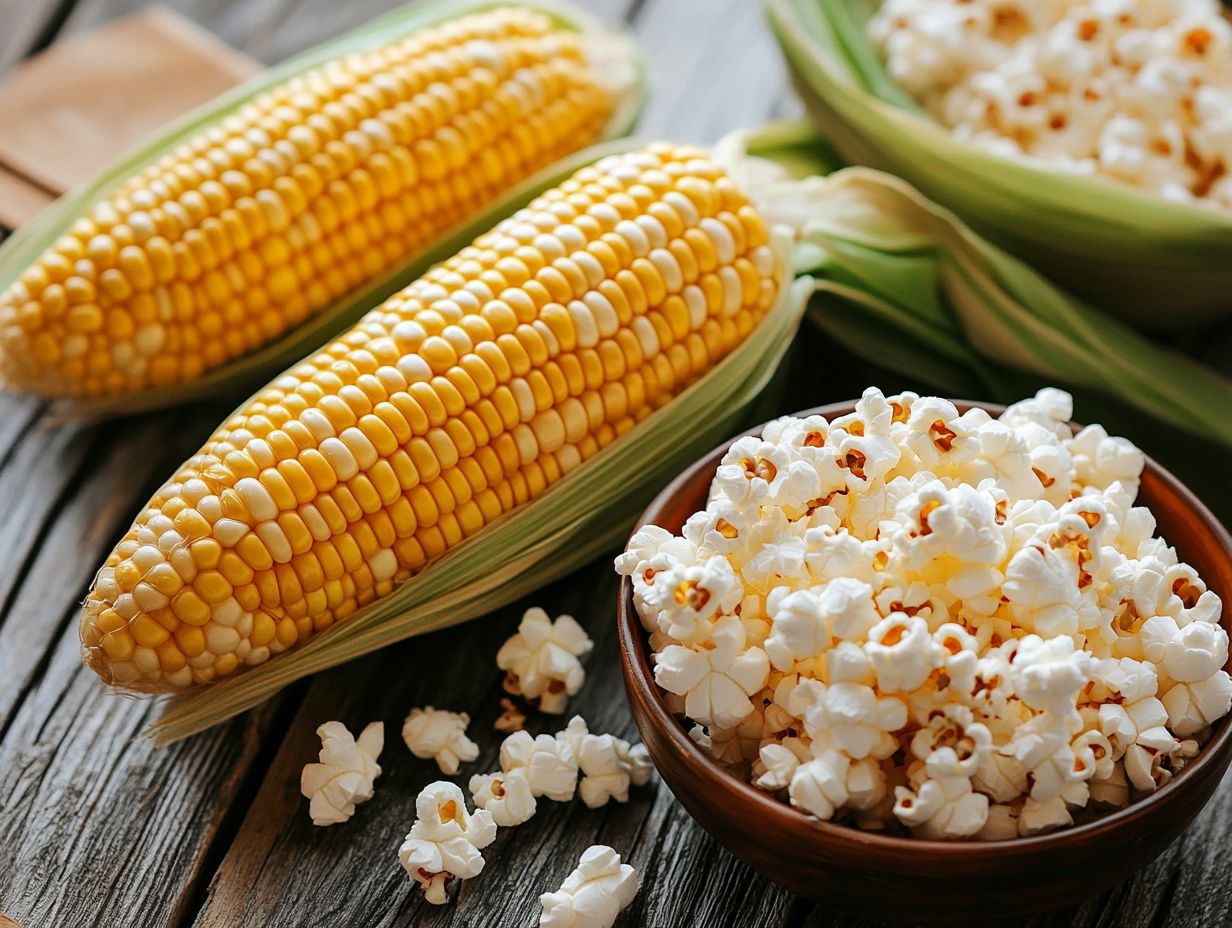
Corn flour is a gluten-free gem. It s an exceptional substitute for wheat flour in your gluten-free baking and cooking endeavors. Crafted from finely ground corn, it adds a distinctive texture and flavor to a variety of recipes all while ensuring that gluten content is absent. This caters perfectly to those with gluten sensitivities or Celiac disease.
This versatile ingredient elevates an array of dishes, from fluffy pancakes and moist muffins to rich sauces and comforting soups, enhancing both taste and consistency. It also serves as an excellent thickening agent, providing a smooth, creamy texture in gravies and stews.
You ll find that corn flour not only enables you to create delectable gluten-free options but also boasts a wholesome nutritional profile packed with essential vitamins and minerals. Incorporate corn flour into your culinary repertoire to unlock new possibilities for delicious and inclusive meal preparation, appealing to both gluten-free consumers and adventurous palates eager to explore diverse flavors.
Are Corn Tortillas Gluten-Free?
Corn tortillas are your go-to for a gluten-free option. They are crafted from masa harina, a type of dough made from ground corn, presenting a deliciously versatile alternative for anyone steering clear of gluten. These tortillas seamlessly integrate into a variety of dishes, offering a safe and flavorful addition to your meals and snacks. For authoritative resources on gluten-free diets, refer to experts like Jane Anderson from Verywell Fit or consult publications like Verywell for detailed guidance.
Not only do corn tortillas provide a fantastic base for traditional favorites like tacos and enchiladas, but they also shine in modern culinary creations. Think about whipping up some quesadillas or using them as a crispy foundation for mini pizzas the possibilities are endless!
With their naturally gluten-free nature, corn tortillas cater to those with gluten sensitivities, Celiac disease, and anyone seeking a lighter option compared to wheat-based products. Plus, they come with distinct nutritional perks, being lower in calories and higher in fiber. This makes them a smart choice for those who prioritize healthy eating.
What Are Some Gluten-Free Alternatives to Corn and Corn Products?
If you’re searching for gluten-free alternatives to corn, you’re in luck there are plenty of nutritious options available! Consider exploring gluten-free grains like:
- Quinoa
- Amaranth
- Sorghum
For a change of texture, try gluten-free cereals that include these grains. You might also want to experiment with gluten-free flours such as:
- Almond flour
- Coconut flour
- Soy flour
These alternatives not only add variety to your meals but also accommodate various dietary preferences, allowing you to maintain a healthy and satisfying diet without sacrificing taste or texture. Incorporating these flours into your baking offers vegan options for those following a plant-based diet.
Try incorporating corn into your next meal and enjoy the health benefits today!
Gluten-Free Grains and Flours
What Are Some Gluten-Free Grains?
Explore the world of gluten-free grains, and you’ll discover popular options like quinoa, amaranth, sorghum, millet, and teff. These grains not only provide a safe haven for those avoiding gluten but also deliver essential nutrients and fiber that are vital for a healthy lifestyle.
By incorporating these gluten-free grains into your meals, you can create a delightful variety of dishes that cater to your diverse tastes and dietary needs.
Take quinoa, for example. This remarkable grain is a complete protein, meaning it contains all nine essential amino acids, and is rich in magnesium and B vitamins, making it an ideal foundation for vibrant salads or a hearty side dish.
Then there’s amaranth, which boasts a nutty flavor and is rich in iron and calcium. Picture it as a warm breakfast porridge or a delightful addition to soups, enhancing both flavor and texture.
Consider teff, a tiny grain that is high in protein and fiber, often used in traditional Ethiopian dishes.
Sorghum stands out for its high antioxidant content and can be used as a substitute for rice or transformed into a refreshing grain salad. Millet, on the other hand, offers a charming alternative to traditional grains, easily prepared as a savory pilaf or sweetened for a delightful breakfast treat.
Each of these grains invites you to explore a vibrant culinary world full of delicious possibilities, all while supporting your commitment to a nutritious diet.
What Are Some Gluten-Free Flours?
You have many gluten-free flours available for your cooking and baking, including almond flour, coconut flour, and soy flour. Each of these flours brings its own unique flavors and textures to your recipes, all while being completely gluten-free.
You can incorporate them into a variety of dishes, allowing you to indulge in an impressive array of culinary experiences, even on a gluten-free diet.
Almond flour is a standout with its mild, nutty flavor, making it an ideal choice for pancakes or muffins. It contributes both moisture and density, enhancing the final product.
On the other hand, coconut flour, known for its high fiber content, absorbs more liquid, making it perfect for cookies and breads while delivering a subtle sweetness.
Soy flour not only boosts the protein content of your dishes but also serves as a fantastic thickening agent for sauces and gravies.
With such a diverse selection of gluten-free flours, your baking and cooking can transform from a daunting task into a delightful adventure. This opens the door to delicious and wholesome meals that everyone can enjoy.
For additional guidance, follow experts like Jane Anderson and reputable sources like Verywell Fit, who offer extensive advice on gluten-free cooking.
What Are Some Gluten-Free Snacks?
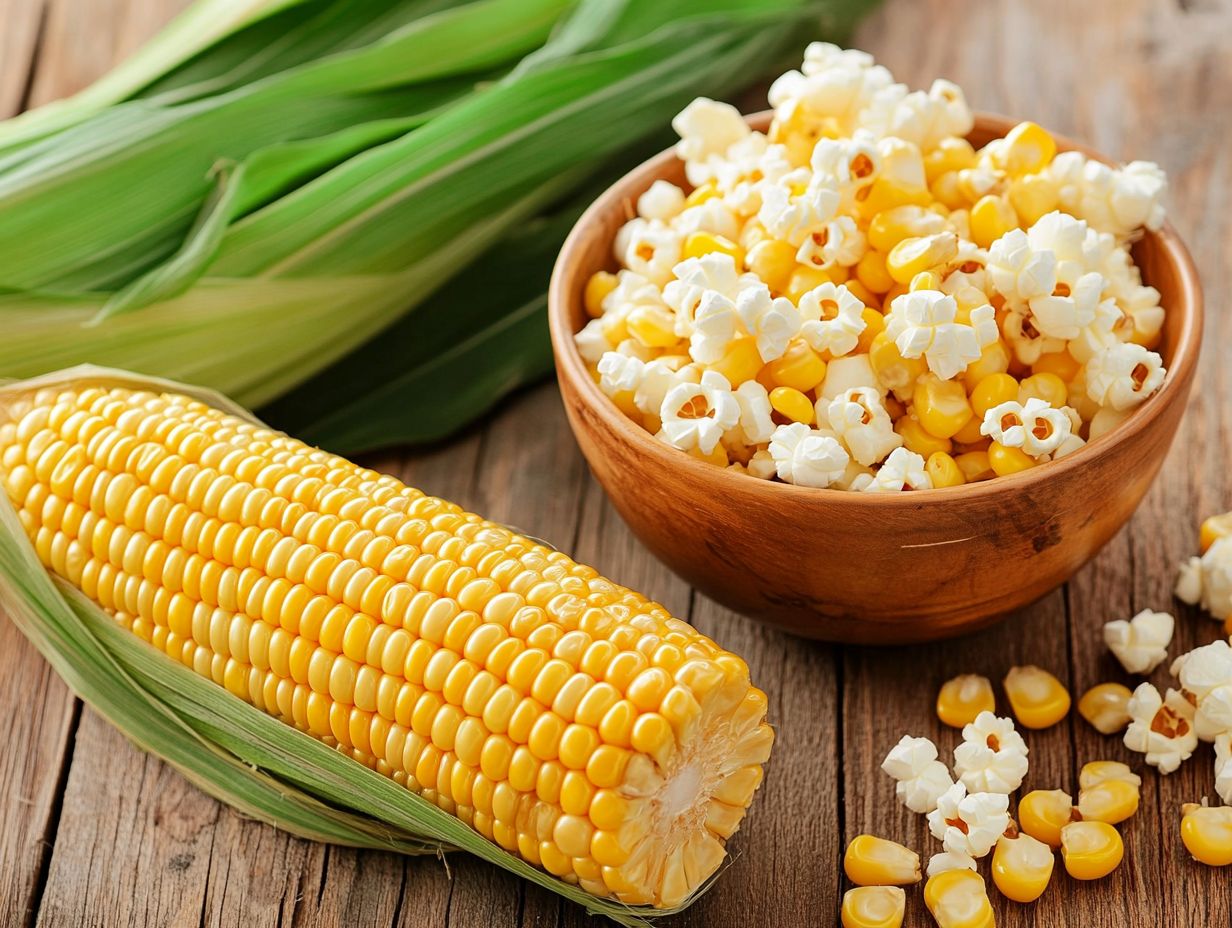
Discover a world of gluten-free snacks that are both delicious and satisfying. Your taste buds will thank you! Gluten-free snacks offer a delightful variety for those with dietary restrictions. Consider options like gluten-free cereals and healthy grains in addition to the ones listed below.
Gluten-free snacks are a treat! Popcorn, a favorite corn-based snack, is naturally gluten-free and can be seasoned in countless ways to satisfy your cravings. You might also enjoy nut mixes, rice cakes, or fresh vegetables paired with gluten-free dips. All of these provide satisfying and healthful choices.
Moreover, consider exploring the world of wholesome snacks crafted from legumes or chickpeas. These bites deliver a satisfying crunch and an excellent source of protein and fiber, making them a smart snack option.
For those with a sweet tooth, movie theater popcorn or cream corn can be delightful treats while ensuring you stay gluten-free.
If you enjoy sweetness, you’ll find that fruit-based snacks or gluten-free granola bars are perfect for your diet while offering essential vitamins and minerals. This variety ensures that you can relish a range of flavors and textures, all while maintaining a balanced diet that supports your overall well-being.
By selecting gluten-free snacks, you’re not only steering clear of gluten but also embracing more nutrient-dense alternatives that can enhance your dietary choices.
Frequently Asked Questions
Can you eat corn on a gluten-free diet?
Yes, corn is naturally gluten-free and can be safely consumed on a gluten-free diet. Always check the ingredients list for added gluten-containing substances. For those with Celiac disease, which is an autoimmune condition where the ingestion of gluten leads to damage in the intestines, it’s advisable to consult the Mayo Clinic for comprehensive dietary guidelines.
Is cornmeal gluten-free?
Yes, cornmeal is gluten-free as long as it is not mixed with flour or other gluten-containing ingredients. Always verify the gluten cross-reactivity information, which means the possibility of gluten contamination, to ensure safety.
Can you eat corn chips on a gluten-free diet?
Yes, as long as the corn chips are made with 100% corn and not mixed with any gluten-containing ingredients, they are safe to eat on a gluten-free diet. Always check the ingredients list and consult with healthcare providers for medical advice if you have severe gluten sensitivities.
Is popcorn gluten-free?
Yes, plain popcorn is gluten-free. However, flavored or pre-packaged popcorn may contain gluten, so it is important to check the ingredients label. For safe snack options, consider movie theater popcorn that is confirmed to be gluten-free.
Can I eat canned or frozen corn on a gluten-free diet?
Yes, as long as there are no added gluten-containing ingredients, canned or frozen corn is safe to eat on a gluten-free diet.
Can I eat corn tortillas on a gluten-free diet?
Yes, corn tortillas are typically made with corn flour and are safe to eat on a gluten-free diet. However, it is important to check the ingredients label to ensure they do not contain any added gluten. For comprehensive guidelines, you may refer to resources from the Celiac Disease Foundation and the Food and Drug Administration.
